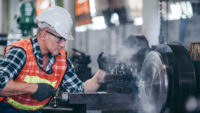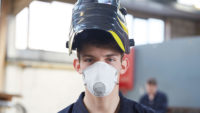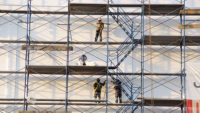Regulation 29 CFR 1910.212
Hazards
Moving machine parts have the potential to cause severe workplace injuries, such as crushed fingers or hands, amputations, burns, or blindness. Employee exposure to unguarded or inadequately guarded machines is prevalent in many workplaces. Consequently, workers who operate and maintain machinery suffer approximately 18,000 amputations, lacerations, crushing injuries, abrasions, and more than 800 deaths per year.
Amputation is one of the most severe and crippling types of injuries in the workplace, and often results in permanent disability. Amputations occur most often when workers operate unguarded or inadequately safeguarded mechanical power presses, power press brakes, powered and non-powered conveyors, printing presses, roll-forming and roll-bending machines, food slicers, meat grinders, meat-cutting band saws, drill presses, and milling machines as well as shears, grinders, and slitters.
Key provisions
- Guards shall be affixed to the machine where possible and secured elsewhere if for any reason attachment to the machine is not possible. The guard shall be such that it does not offer an accident hazard in itself.
- The point of operation — the area on a machine where work is actually performed upon the material being processed — must be guarded with a device that is designed and constructed as to prevent the operator from having any part of his body in the danger zone during the operating cycle.
- Special hand tools for placing and removing material shall be such as to permit easy handling of material without the operator placing a hand in the danger zone. Such tools shall not be in lieu of other guarding that’s required, but can only be used to supplement protection provided.
- Some of the machines which usually require point of operation guarding are guillotine cutters, shears, alligator shears, power presses, milling machines, power saws, jointers, portable power tools, forming rolls and calenders.
- Revolving drums, barrels, and containers must be guarded by an enclosure which is interlocked with the drive mechanism, so that the barrel, drum, or container cannot revolve unless the guard enclosure is in place.
- Exposure of blades: when the periphery of the blades of a fan is less than seven (7) feet above the floor or working level, the blades shall be guarded. The guard shall have openings no larger than one-half (1/2) inch.
- Machines designed for a fixed location shall be securely anchored to prevent walking or moving.
General machine guarding safety measures
- Identify the hazards of the machines being used.
- Conduct regular inspections and keep machinery clean and properly maintained.
- Train workers on machine-operating procedures.
- Establish procedures for addressing unsafe conditions.
- Ensure that only trained workers operate machinery and that they do not wear loose-fitting clothing that could become entangled in the machinery.
- Prohibit other workers from being near the machine during operations.





